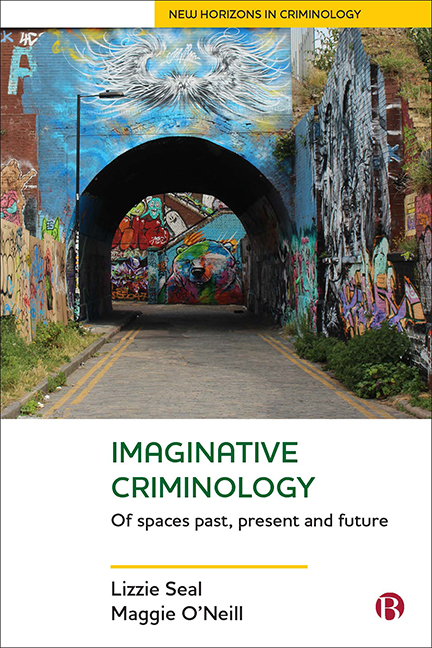Book contents
- Frontmatter
- Contents
- List of figures and tables
- Preface
- 1 Imaginative Criminologies of Space: the Spaces of Imaginative Criminology
- 2 Historical Spaces of Confinement 1: Homes for Indigenous Children in Australia
- 3 Historical Spaces of Confinement 2: Magdalene Laundries
- 4 Creative Writing and the Imagined Spaces of Imprisonment
- 5 Border Spaces and Places: the Age of the Camps
- 6 Imagining Spaces of Violence and Transgression in Vancouver and Northern Ireland
- 7 Imagining Dystopian Futures in Young Adult Fiction
- 8 Conclusion
- References
- Index
5 - Border Spaces and Places: the Age of the Camps
Published online by Cambridge University Press: 30 April 2022
- Frontmatter
- Contents
- List of figures and tables
- Preface
- 1 Imaginative Criminologies of Space: the Spaces of Imaginative Criminology
- 2 Historical Spaces of Confinement 1: Homes for Indigenous Children in Australia
- 3 Historical Spaces of Confinement 2: Magdalene Laundries
- 4 Creative Writing and the Imagined Spaces of Imprisonment
- 5 Border Spaces and Places: the Age of the Camps
- 6 Imagining Spaces of Violence and Transgression in Vancouver and Northern Ireland
- 7 Imagining Dystopian Futures in Young Adult Fiction
- 8 Conclusion
- References
- Index
Summary
Continuing the focus on space and place in imaginative criminology, this chapter discusses arts-based research (film and walking ethnographies) with asylum seekers and migrants waiting in border spaces, mostly in camps (in Greece, Syria and Melilla). The construction of the camp as a temporal, liminal, spatial site of containment and constraint, and a border space, and what this means in the lives of the people and families waiting, some for many years, is examined through narrative interviews, photographs and filmic work.
In this chapter we continue the themes discussed in previous chapters, including the relationship of space and time; liminal in-between spaces; and the usefulness of a threefold analysis of space through the relational, embodied and imagined experiences of migrants. We also develop our analysis of border spaces and places and the impact on the lives of people on the move and crossing borders, through micrology of their lived experience. As we argued in Chapter 1, focusing on micrology (the minutiae, the small scale) of lived experience can often help to shed light on and deconstruct broader structures (and discourses) that are not only the outcome but the medium of social action and meaning making. Walking methods are a particularly relevant, helpful and potentially groundbreaking way of studying borders, and the relational, embodied and imagined (O’Neill and Hubbard, 2010) experiences involved in physically crossing borders, going into areas perceived as ‘risky’ or, literally, walking the border. Borders can also be internalised and walking is a powerful route to understand the lived experiences of others as well as eliciting rich phenomenological material as an imaginative criminological method.
The concept and analysis of ‘mental space’ is helpful here too (see Chapter 4), connecting with Massey's (2005) notion of space as imagined as ‘open to the future’. In an increasingly interconnected world, Massey argues that space is the result of interrelations and interactions; it is the sphere of the multiple existence of possibilities, of ‘coexisting heterogeneity’ and is always ‘under construction’ (p 9). In articulating a deeper analysis and understanding of ‘space’ in social theory Massey (p 13) is also concerned with a ‘politics that can respond’ to this.
- Type
- Chapter
- Information
- Imaginative CriminologyOf Spaces Past, Present and Future, pp. 73 - 92Publisher: Bristol University PressPrint publication year: 2019

